heater FORD POLICE INTERCEPTOR SEDAN 2014 1.G Owners Manual
[x] Cancel search | Manufacturer: FORD, Model Year: 2014, Model line: POLICE INTERCEPTOR SEDAN, Model: FORD POLICE INTERCEPTOR SEDAN 2014 1.GPages: 406, PDF Size: 6.86 MB
Page 4 of 406
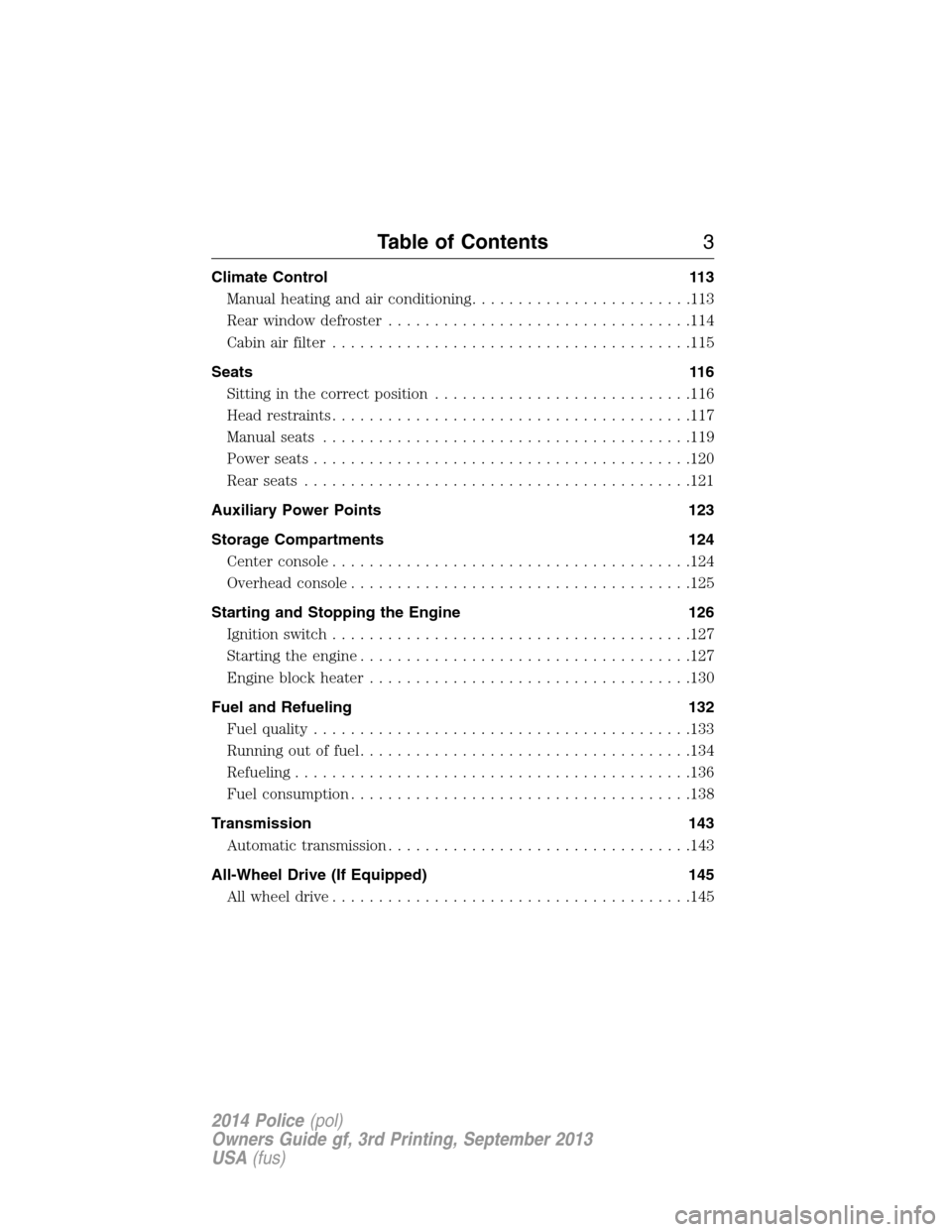
Climate Control 113
Manual heating and air conditioning........................113
Rear window defroster.................................114
Cabin air filter.......................................115
Seats 116
Sitting in the correct position............................116
Head restraints.......................................117
Manual seats........................................119
Power seats.........................................120
Rear seats..........................................121
Auxiliary Power Points 123
Storage Compartments 124
Center console.......................................124
Overhead console.....................................125
Starting and Stopping the Engine 126
Ignition switch.......................................127
Starting the engine....................................127
Engine block heater...................................130
Fuel and Refueling 132
Fuel quality.........................................133
Running out of fuel....................................134
Refueling...........................................136
Fuel consumption.....................................138
Transmission 143
Automatic transmission.................................143
All-Wheel Drive (If Equipped) 145
All wheel drive.......................................145
Table of Contents3
2014 Police(pol)
Owners Guide gf, 3rd Printing, September 2013
USA(fus)
Page 130 of 406
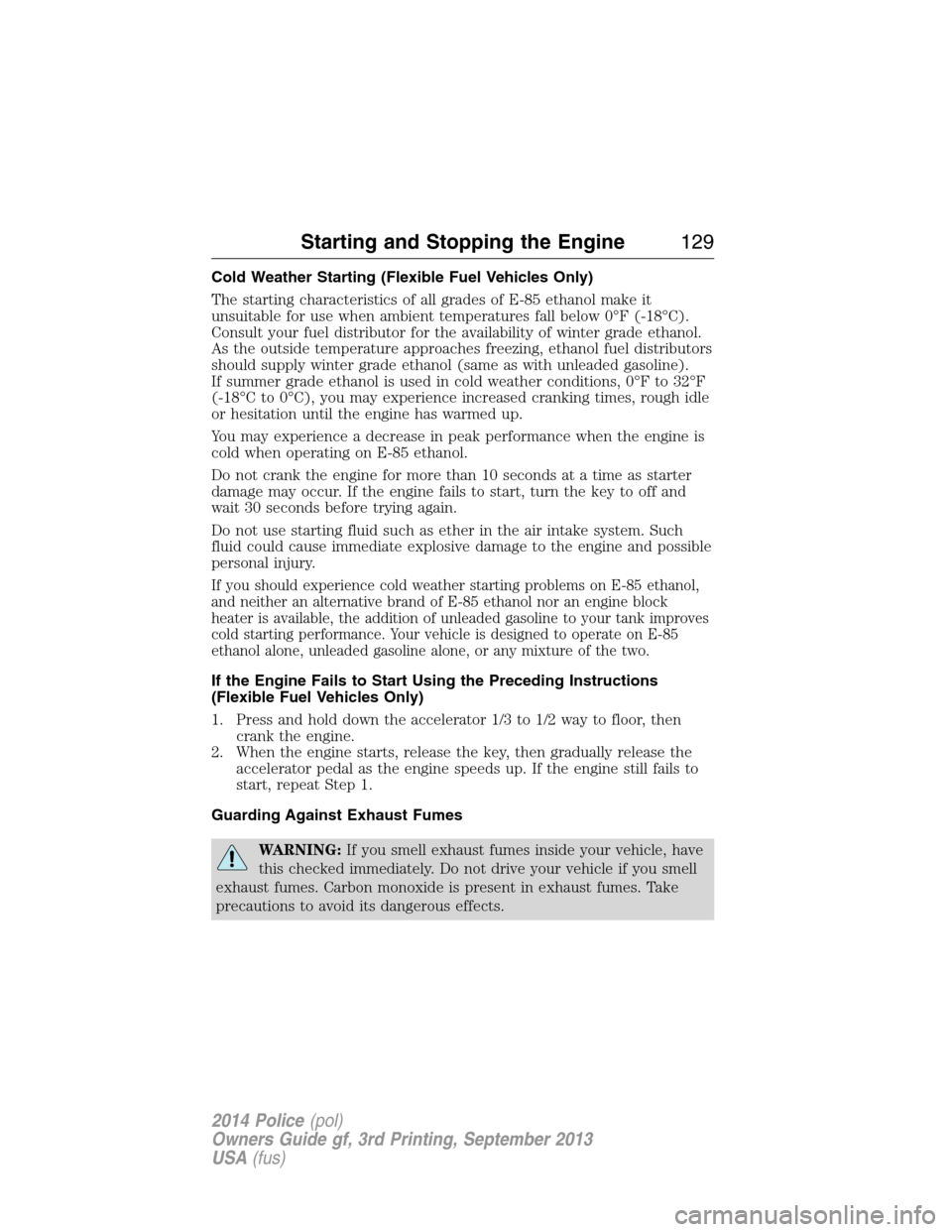
Cold Weather Starting (Flexible Fuel Vehicles Only)
The starting characteristics of all grades of E-85 ethanol make it
unsuitable for use when ambient temperatures fall below 0°F (-18°C).
Consult your fuel distributor for the availability of winter grade ethanol.
As the outside temperature approaches freezing, ethanol fuel distributors
should supply winter grade ethanol (same as with unleaded gasoline).
If summer grade ethanol is used in cold weather conditions, 0°F to 32°F
(-18°C to 0°C), you may experience increased cranking times, rough idle
or hesitation until the engine has warmed up.
You may experience a decrease in peak performance when the engine is
cold when operating on E-85 ethanol.
Do not crank the engine for more than 10 seconds at a time as starter
damage may occur. If the engine fails to start, turn the key to off and
wait 30 seconds before trying again.
Do not use starting fluid such as ether in the air intake system. Such
fluid could cause immediate explosive damage to the engine and possible
personal injury.
If you should experience cold weather starting problems on E-85 ethanol,
and neither an alternative brand of E-85 ethanol nor an engine block
heater is available, the addition of unleaded gasoline to your tank improves
cold starting performance. Your vehicle is designed to operate on E-85
ethanol alone, unleaded gasoline alone, or any mixture of the two.
If the Engine Fails to Start Using the Preceding Instructions
(Flexible Fuel Vehicles Only)
1. Press and hold down the accelerator 1/3 to 1/2 way to floor, then
crank the engine.
2. When the engine starts, release the key, then gradually release the
accelerator pedal as the engine speeds up. If the engine still fails to
start, repeat Step 1.
Guarding Against Exhaust Fumes
WARNING:If you smell exhaust fumes inside your vehicle, have
this checked immediately. Do not drive your vehicle if you smell
exhaust fumes. Carbon monoxide is present in exhaust fumes. Take
precautions to avoid its dangerous effects.
Starting and Stopping the Engine129
2014 Police(pol)
Owners Guide gf, 3rd Printing, September 2013
USA(fus)
Page 131 of 406

Important Ventilating Information
If you stop your vehicle and leave the engine idling for long periods, we
recommend that you do one of the following:
•Open the windows at least 1 inch (2.5 centimeters).
•Set your climate control to outside air.
ENGINE BLOCK HEATER (IF EQUIPPED)
WARNING:Failure to follow engine block heater instructions
could result in property damage or personal injury.
WARNING:Do not use your heater with ungrounded electrical
systems or two-pronged (cheater) adapters. There is a risk of
electrical shock.
Note:The heater is most effective when outdoor temperatures are below
0°F (-18°C).
The heater acts as a starting aid by warming the engine coolant. This
allows the climate control system to respond quickly. The equipment
includes a heater element (installed in the engine block) and a wire
harness. You can connect the system to a grounded 120–volt A/C
electrical source.
We recommend that you do the following for safe and correct operation:
•Use a 16-gauge outdoor extension cord that is product certified
by Underwriter’s Laboratory or Canadian Standards Association.
This extension cord must be suitable for use outdoors, in cold
temperatures, and be clearly markedSuitable for Use with Outdoor
Appliances.Never use an indoor extension cord outdoors; it could
result in an electric shock or become a fire hazard.
•Use as short an extension cord as possible.
•Do not use multiple extension cords.
•Make sure that when in operation, the extension cord plug and the
heater cord plug connections are free and clear of water. This could
cause an electric shock or fire.
130Starting and Stopping the Engine
2014 Police(pol)
Owners Guide gf, 3rd Printing, September 2013
USA(fus)
Page 132 of 406
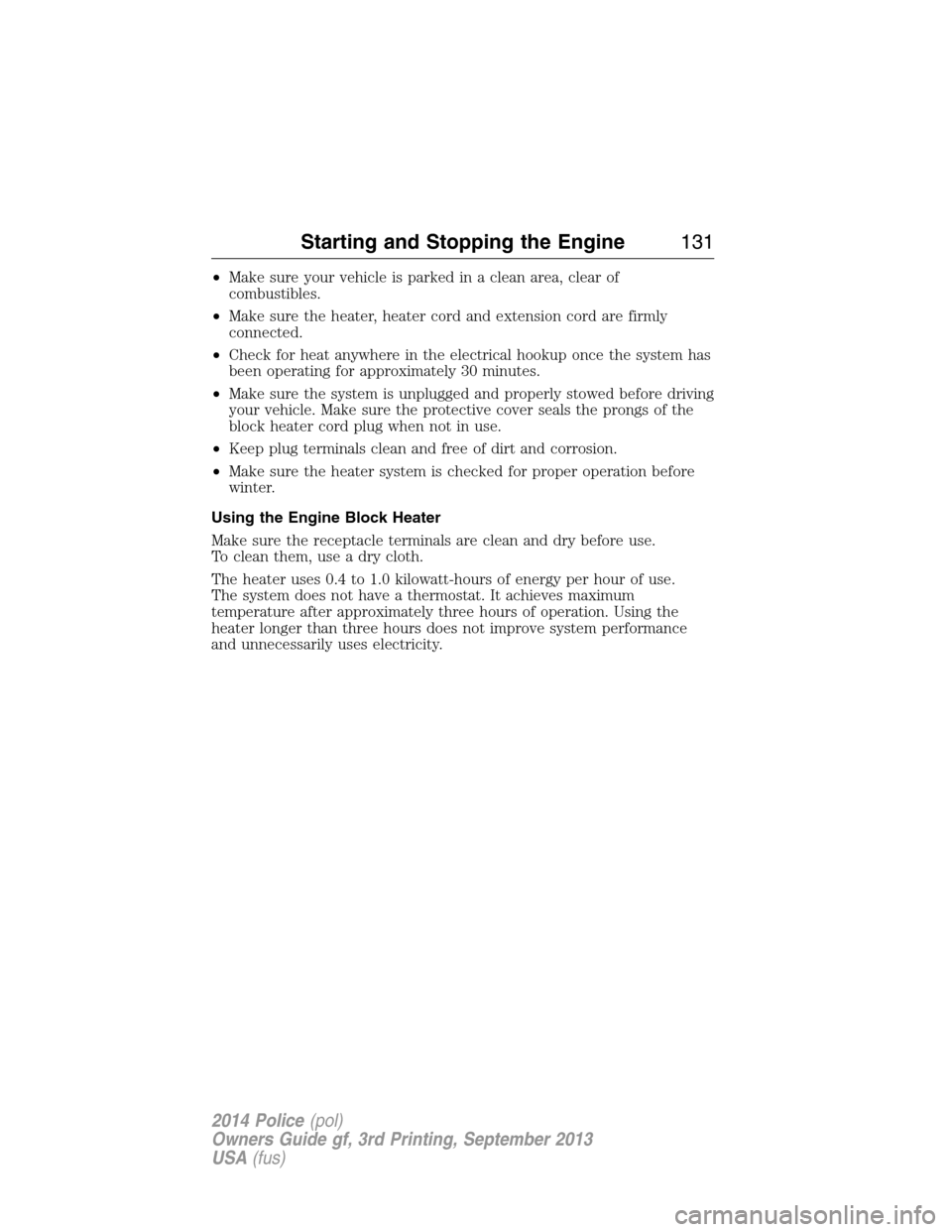
•Make sure your vehicle is parked in a clean area, clear of
combustibles.
•Make sure the heater, heater cord and extension cord are firmly
connected.
•Check for heat anywhere in the electrical hookup once the system has
been operating for approximately 30 minutes.
•Make sure the system is unplugged and properly stowed before driving
your vehicle. Make sure the protective cover seals the prongs of the
block heater cord plug when not in use.
•Keep plug terminals clean and free of dirt and corrosion.
•Make sure the heater system is checked for proper operation before
winter.
Using the Engine Block Heater
Make sure the receptacle terminals are clean and dry before use.
To clean them, use a dry cloth.
The heater uses 0.4 to 1.0 kilowatt-hours of energy per hour of use.
The system does not have a thermostat. It achieves maximum
temperature after approximately three hours of operation. Using the
heater longer than three hours does not improve system performance
and unnecessarily uses electricity.
Starting and Stopping the Engine131
2014 Police(pol)
Owners Guide gf, 3rd Printing, September 2013
USA(fus)
Page 197 of 406
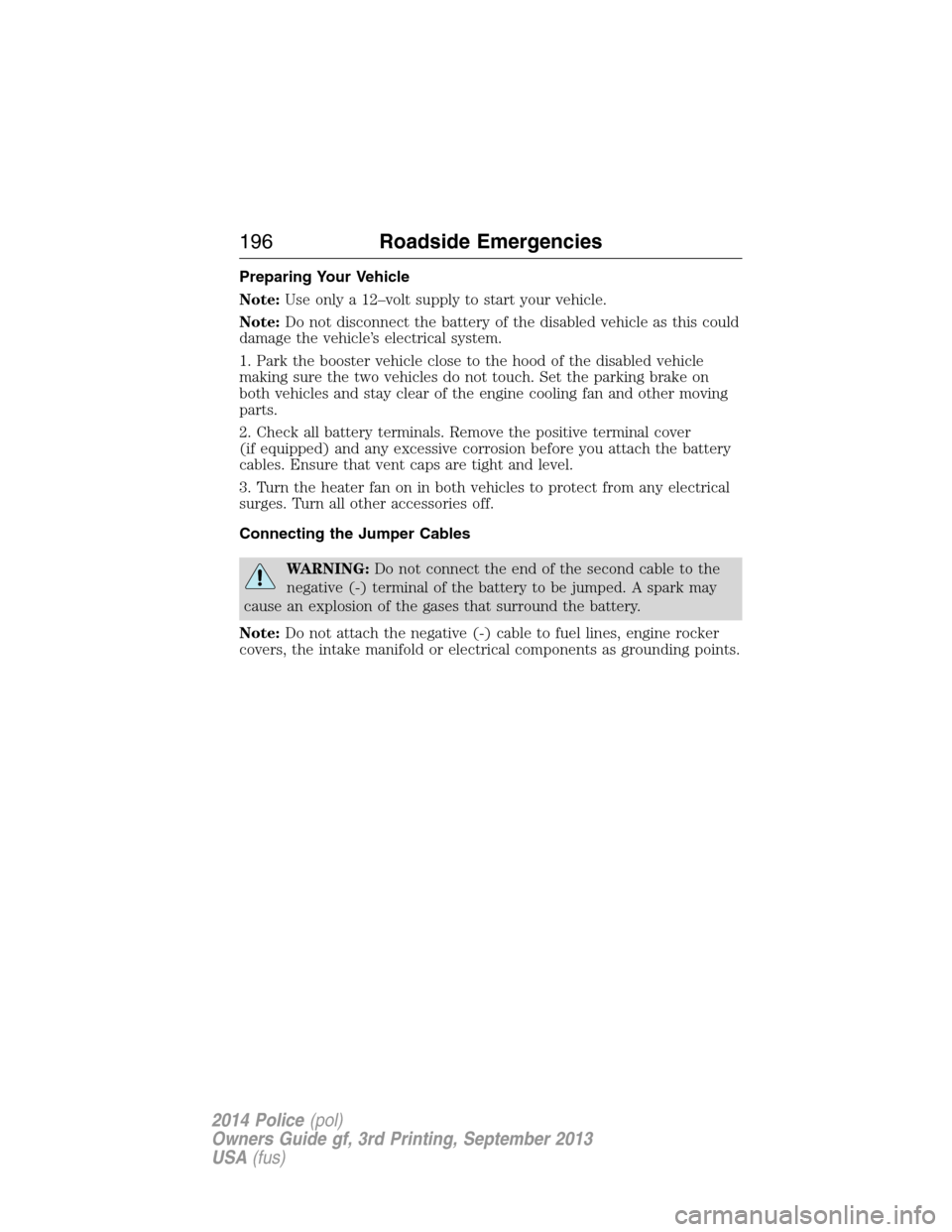
Preparing Your Vehicle
Note:Use only a 12–volt supply to start your vehicle.
Note:Do not disconnect the battery of the disabled vehicle as this could
damage the vehicle’s electrical system.
1. Park the booster vehicle close to the hood of the disabled vehicle
making sure the two vehicles do not touch. Set the parking brake on
both vehicles and stay clear of the engine cooling fan and other moving
parts.
2. Check all battery terminals. Remove the positive terminal cover
(if equipped) and any excessive corrosion before you attach the battery
cables. Ensure that vent caps are tight and level.
3. Turn the heater fan on in both vehicles to protect from any electrical
surges. Turn all other accessories off.
Connecting the Jumper Cables
WARNING:Do not connect the end of the second cable to the
negative (-) terminal of the battery to be jumped. A spark may
cause an explosion of the gases that surround the battery.
Note:Do not attach the negative (-) cable to fuel lines, engine rocker
covers, the intake manifold or electrical components as grounding points.
196Roadside Emergencies
2014 Police(pol)
Owners Guide gf, 3rd Printing, September 2013
USA(fus)
Page 212 of 406

Fuse or relay
numberFuse amp
ratingProtected components
53 — Left-hand trailer tow stop/turn
lamps relay (Utility)
54 — Not used
55 — Wiper relay
56 — Not used
57 — Not used
58 10A* Alternator A-line
59 10A* Brake on/off switch
60 — Not used
61 — Not used
62 10A* Air conditioner clutch relay
63 15A* Trailer tow stop/turn lamps
(Utility)
64 15A* Rear wipers (Utility)
65 30A* Fuel pump relay
66 — Powertrain control module relay
67 20A* Oxygen sensor heater, Mass
airflow sensor, Variable camshaft
timing solenoid valve, Canister
vent solenoid, Canister purge
solenoid
68 20A* Ignition coils
69 20A* Vehicle power #1 (Powertrain
control module)
Fuses211
2014 Police(pol)
Owners Guide gf, 3rd Printing, September 2013
USA(fus)
Page 213 of 406
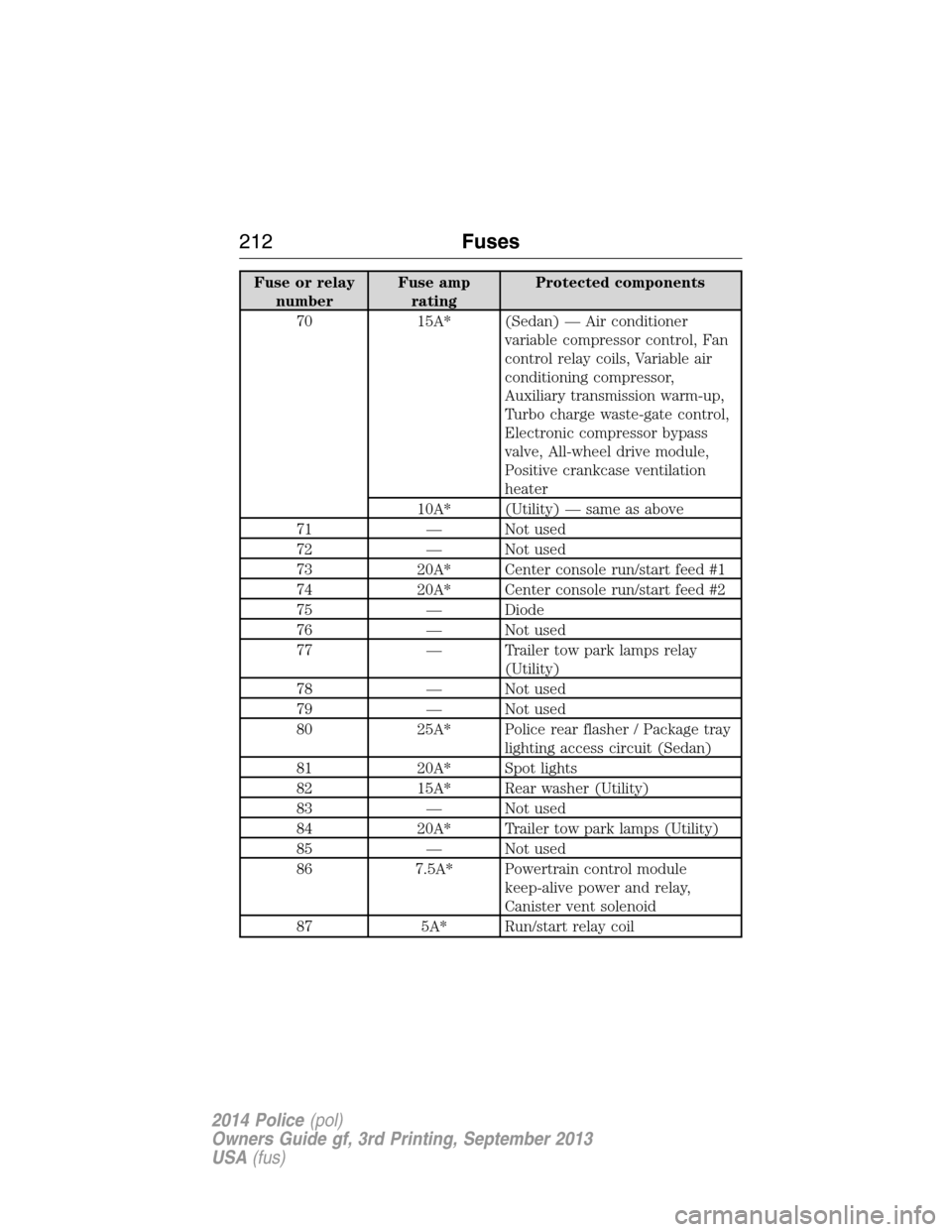
Fuse or relay
numberFuse amp
ratingProtected components
70 15A* (Sedan) — Air conditioner
variable compressor control, Fan
control relay coils, Variable air
conditioning compressor,
Auxiliary transmission warm-up,
Turbo charge waste-gate control,
Electronic compressor bypass
valve, All-wheel drive module,
Positive crankcase ventilation
heater
10A* (Utility) — same as above
71 — Not used
72 — Not used
73 20A* Center console run/start feed #1
74 20A* Center console run/start feed #2
75 — Diode
76 — Not used
77 — Trailer tow park lamps relay
(Utility)
78 — Not used
79 — Not used
80 25A* Police rear flasher / Package tray
lighting access circuit (Sedan)
81 20A* Spot lights
82 15A* Rear washer (Utility)
83 — Not used
84 20A* Trailer tow park lamps (Utility)
85 — Not used
86 7.5A* Powertrain control module
keep-alive power and relay,
Canister vent solenoid
87 5A* Run/start relay coil
212Fuses
2014 Police(pol)
Owners Guide gf, 3rd Printing, September 2013
USA(fus)
Page 384 of 406
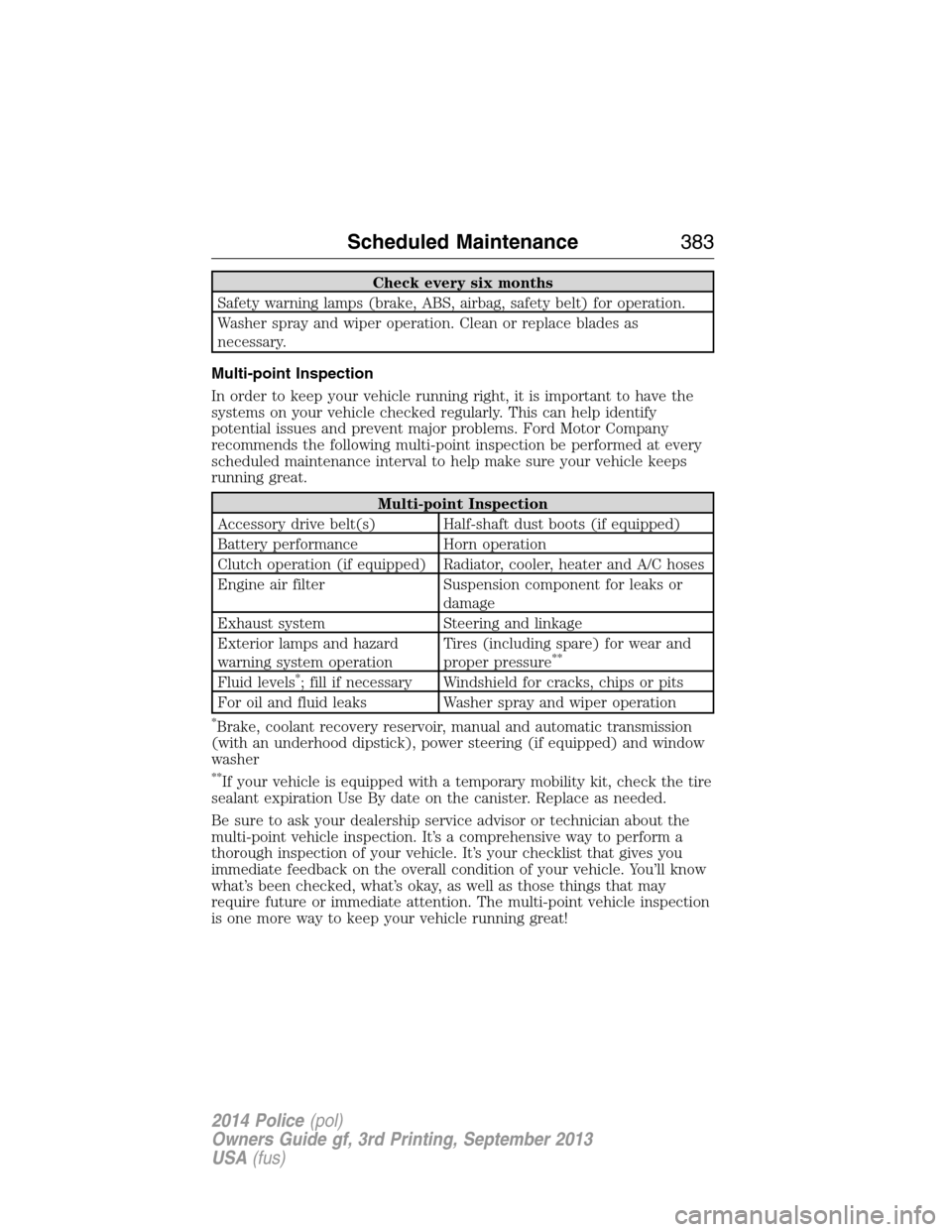
Check every six months
Safety warning lamps (brake, ABS, airbag, safety belt) for operation.
Washer spray and wiper operation. Clean or replace blades as
necessary.
Multi-point Inspection
In order to keep your vehicle running right, it is important to have the
systems on your vehicle checked regularly. This can help identify
potential issues and prevent major problems. Ford Motor Company
recommends the following multi-point inspection be performed at every
scheduled maintenance interval to help make sure your vehicle keeps
running great.
Multi-point Inspection
Accessory drive belt(s) Half-shaft dust boots (if equipped)
Battery performance Horn operation
Clutch operation (if equipped) Radiator, cooler, heater and A/C hoses
Engine air filter Suspension component for leaks or
damage
Exhaust system Steering and linkage
Exterior lamps and hazard
warning system operationTires (including spare) for wear and
proper pressure
**
Fluid levels*; fill if necessary Windshield for cracks, chips or pits
For oil and fluid leaks Washer spray and wiper operation
*Brake, coolant recovery reservoir, manual and automatic transmission
(with an underhood dipstick), power steering (if equipped) and window
washer
**If your vehicle is equipped with a temporary mobility kit, check the tire
sealant expiration Use By date on the canister. Replace as needed.
Be sure to ask your dealership service advisor or technician about the
multi-point vehicle inspection. It’s a comprehensive way to perform a
thorough inspection of your vehicle. It’s your checklist that gives you
immediate feedback on the overall condition of your vehicle. You’ll know
what’s been checked, what’s okay, as well as those things that may
require future or immediate attention. The multi-point vehicle inspection
is one more way to keep your vehicle running great!
Scheduled Maintenance383
2014 Police(pol)
Owners Guide gf, 3rd Printing, September 2013
USA(fus)
Page 402 of 406
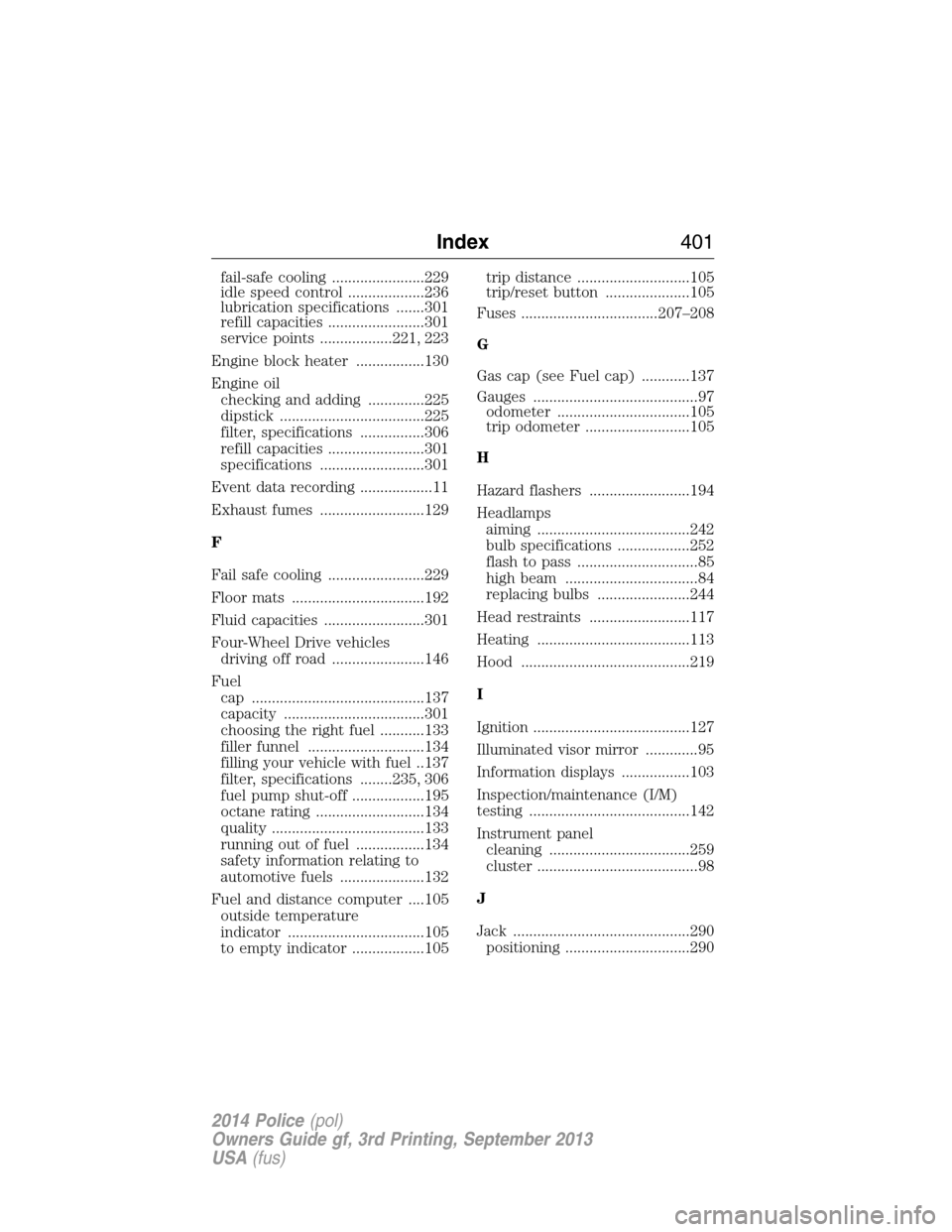
fail-safe cooling .......................229
idle speed control ...................236
lubrication specifications .......301
refill capacities ........................301
service points ..................221, 223
Engine block heater .................130
Engine oil
checking and adding ..............225
dipstick ....................................225
filter, specifications ................306
refill capacities ........................301
specifications ..........................301
Event data recording ..................11
Exhaust fumes ..........................129
F
Fail safe cooling ........................229
Floor mats .................................192
Fluid capacities .........................301
Four-Wheel Drive vehicles
driving off road .......................146
Fuel
cap ...........................................137
capacity ...................................301
choosing the right fuel ...........133
filler funnel .............................134
filling your vehicle with fuel ..137
filter, specifications ........235, 306
fuel pump shut-off ..................195
octane rating ...........................134
quality ......................................133
running out of fuel .................134
safety information relating to
automotive fuels .....................132
Fuel and distance computer ....105
outside temperature
indicator ..................................105
to empty indicator ..................105trip distance ............................105
trip/reset button .....................105
Fuses ..................................207–208
G
Gas cap (see Fuel cap) ............137
Gauges .........................................97
odometer .................................105
trip odometer ..........................105
H
Hazard flashers .........................194
Headlamps
aiming ......................................242
bulb specifications ..................252
flash to pass ..............................85
high beam .................................84
replacing bulbs .......................244
Head restraints .........................117
Heating ......................................113
Hood ..........................................219
I
Ignition .......................................127
Illuminated visor mirror .............95
Information displays .................103
Inspection/maintenance (I/M)
testing ........................................142
Instrument panel
cleaning ...................................259
cluster ........................................98
J
Jack ............................................290
positioning ...............................290
Index401
2014 Police(pol)
Owners Guide gf, 3rd Printing, September 2013
USA(fus)